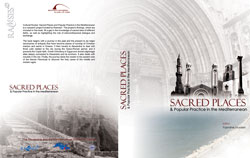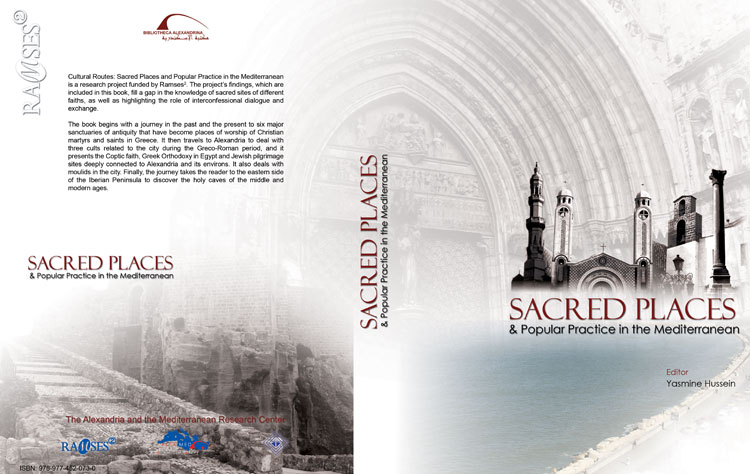 Publications
Publications

The Book and The Research:
"Sacred Places and Popular Practice in the Mediterranean"
Part I Greece:
"Orthodox Christian holidays in place of ancient shrines in Greece. Evidence of European travelers and pilgrims presence (XVII-XXI century)" by Ioli Vingopoulou:
Ioli Vingopoulou presents a chapter about Orthodox Christian holidays celebrated on the sites of ancient shrines or sanctuaries. Major sanctuaries of antiquity, especially in southern Greece (Delphi, Olympia, Athens and Delos) where mainly Panhellenic games took place every four years, attracted people both to participate in and attend the games, and to worship the gods. With the end of the ancient world, these shrines lost their role and Christianity gradually spread in the same places. Thus, places of worship of the Olympian pantheon became sites of worship of new martyrs and saints, and Christian churches were built in almost the same places. These sites have continued to shelter places of pilgrimage and worship.
- Eleusis
Eleusis, today an industrial city, was once the center of the cult of Demeter, the goddess of harvest, fertility and the seasons, and her daughter Persephone. In antiquity, the annual Eleusinian mysteries attributed to Demeter and Persephone involved important ceremonies and rituals attended by Greeks of all classes. These celebrations and the cult of Demeter lasted until the end of the fourth century when they were forbidden by Emperor Theodosius. Today, on the same site in Eleusis stands a chapel dedicated to the « Mesosporitissa » Virgin, or « Virgin of the Sowing Season », where an annual mass is dedicated to her during November.



- Patras
Patras is the third largest city and the third important port in the country. In Patras, there was an ancient oracle, over a sacred spring, dedicated to the goddess Demeter. On the other hand the city of Patras was sanctified by the blood of Saint Andrew, the Protoclytos. The location of the miraculous spring was the same place where the apostle preached.



- Athens
In ancient times, Athens was celebrated every four years feast in honor of the goddess Athena, the Panathenaic on 28 hecatomvaionos (July-August), the anniversary of the goddess Athena. The main part of the feast was the processions that pass through the Agora. At this site of the ancient Agora, is a district inhabited throughout the Byzantine period and the period of Ottoman occupation until the beginning of excavations in 1931. And a church dedicated to saints has existed on this site since 1000 C.E. until today. The church, as an archeological monument, does not open to the people except the day of the Feast of the Holy Apostles (June 29-30).



- Chios
Chios is an island in the north-eastern Aegean Sea. At the highest hilltop in the southern part of the island, the church of the prophet Elijah is next to a shrine of the goddess Athena over the small port of Emboreios. The feast of the Panygyri on 20 July receives the pilgrims, locals and foreigners, every year in the same place of the old site of the shrine of the goddess Athena.



- Delos
In the middle of the Aegean is an island sacred to the ancient Greek world: Delos, birthplace of the god Apollo. According to the myth, Delos the birthplace of Apollo is a city of music, dance and songs even during the sacrifices rituals the sacred choir of women continued to chant. Today the island is uninhabited but a small chapel dedicated to Saint Kyriaki, was built in the early twentieth century among the ruins of the stadium district, in the region where there was the sanctuary of the legendary founder and first King of Delos. The sixth day (day sacred to the goddess Artemis sister of Apollo) of July (month sacred to the goddess Aphrodite) is the day of the feast of Saint Kyriaki "athléphore". The authorities exceptionally allow the visit to the site for the feast.



- Delphi
To honor Apollo, they celebrated feasts (Delphinia, Thargelia, Septéria, Théophneia, Liknites and others) which recall certain events in his life. In honor of the god's victory over the dragon and its purification was celebrated with great pomp at Delphi's big sanctuary and oracle of Apollo, the "Pythia". The first representations of Saint George show him standing in military uniform and since the eleventh century, he appears killing the dragon. His feast (23 April) is always celebrated at Delphi and Arachova.
Like Apollo, who slew the dragon Python and instituted its oracle, Saint George killed the dragon and freed the waters. The popular song of today combines the two legends in Delphi and Arachova.
























